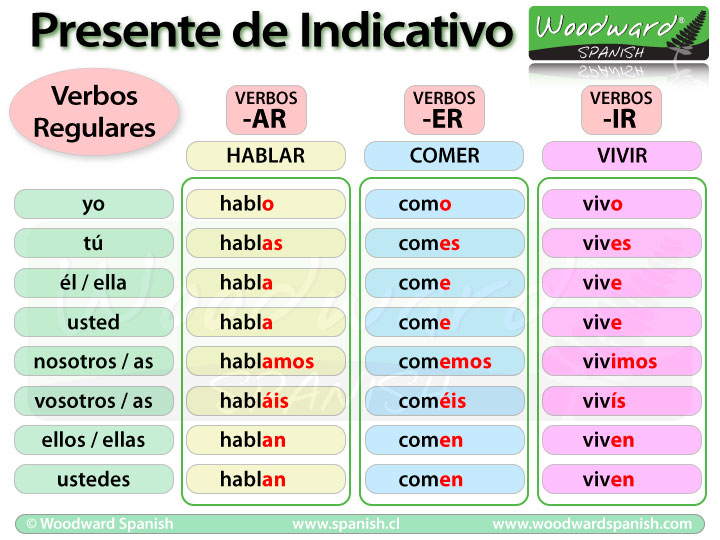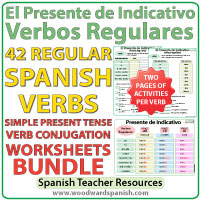
With regular verbs in Spanish, only the ending part of that verb (the -ar, -er or -ir part) changes depending on who does the action. However, unlike English, there is a different ending for each subject (pronoun).
To begin, we will show you how to conjugate the verb in the present tense:
(Notice how the part of the verb in red is the part that changes)

Teachers/Parents: There is a free version of this chart here: Free Spanish Present Tense - Regular Verbs Chart
Before you continue reading, make sure you know about Subject Pronouns in Spanish (yo, tú, él etc.).
If you have the verb Hablar (to speak) and you want to say "I speak". You just remove the last two letters of the verb (in this case remove the -ar) and add the letter -O to the end to create the conjugated verb Hablo which means "I speak".
Another example: if you want to say "They eat", we take the original verb, in this case Comer, we remove the ending (-er) and then add -EN to the end (because ellos = they). We now have Comen (they eat).
You will notice that certain verb endings are repeated. For example for YO (I) we take off the ending for all regular verbs and add the -O to the root (main part) of the verb.
Also see how the only difference between -ER verbs and -IR verb endings is when we use nosotros (we) and vosotros (you/plural/informal).
The subject pronoun (yo, tú, nosotros etc.) is often omitted before the verb since we normally know who the subject (the person doing the action) is because of the verb's ending.
For example: If you say "Hablamos español" (we speak Spanish). You don't need to put the pronoun nosotros before the verb because we know that when we say hablamos, it refers to nosotros (we). So often you will hear or just read "Hablamos español" without the pronoun nosotros.
The following verbs are only irregular in the first person (singular). The rest of the conjugations are as normal (see regular verbs above).
I.- First Person Verbs ending in -Y
The following verbs are a part of this group: Estar (to be) - Dar (to give)
II.- First Person Verbs ending in -GO
The following verbs are a part of this group: Hacer (to do) - Poner (to put) - Salir (to go out) - Valer (to cost/be worth)
III.- First Person Verbs ending in -ZCO
Verbs that end in -cir and -cer change to -zco in first person. The following verbs are a part of this group: Conducir (to drive) - Conocer (to know) - Traducir (to translate)
Remember these verbs are only irregular in the first person (singular), the rest of the verb has the same rules as regular present tense conjugations.
There are four types of verbs where the stem of the verb is irregular and changes. In the present tense these are verbs that change their stem from O to UE, from U to UE, E to IE, and E to I. Note that this stem change does not happen when the verb is for nosotros o vosotros (these maintain the original stem of the verb).
I.- Stem changes from O to UE
The letter "O" in the stem of the infinitive verb changes to "UE" in the conjugations.
II.- Stem changes from E to IE
The letter "E" in the stem of the infinitive verb changes to "IE" in the conjugations.
III.- Stem changes from E to I
The letter "E" in the stem of the infinitive verb changes to "I" in the conjugations.
IV.- Stem changes from U to UE
The letter "U" in the stem of the infinitive verb changes to "UE" in the conjugations. Note that the verb Jugar is the only verb that is irregular in this way.
Try our interactive games to practice the present tense in Spanish:
Hablar Comer Vivir 1 - Present Tense conjugation
Hablar Comer Vivir 2 - Present Tense conjugation
Hablar Comer Vivir 3 - Present Tense conjugation
Hablar Comer Vivir 4 - Present Tense conjugation
See our notes written in Spanish about the Present Tense (El Presente Indicativo)

If you found this guide about the Spanish Present Tense interesting or useful, let others know about it.
Boost your Spanish language skills with our interactive multiple-choice quizzes! Our Spanish grammar and vocabulary quizzes are for beginners to advanced level learners and offer a fun and effective way to learn and practice Spanish. So, start playing these interactive games and make your language learning journey enjoyable and rewarding.
Spanish language resources for teachers, students, and parents: Lesson plans, Spanish grammar worksheets, Spanish vocabulary flash cards and charts, task cards, Spanish reading comprehension activities, classroom posters and decorations, word searches, and PDFs that allow students to become actively engaged in their learning.